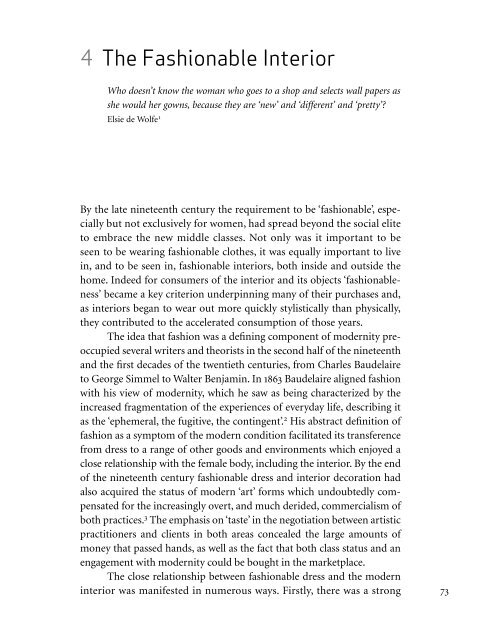You also want an ePaper? Increase the reach of your titles
YUMPU automatically turns print PDFs into web optimized ePapers that Google loves.
4 <strong>The</strong> Fashionable <strong>Interior</strong><br />
Who doesn’t know the woman who goes to a shop and selects wall papers as<br />
she would her gowns, because they are ‘new’ and ‘different’ and ‘pretty’?<br />
Elsie de Wolfe1 By the late nineteenth century the requirement to be ‘fashionable’, especially<br />
but not exclusively for women, had spread beyond the social elite<br />
to embrace the new middle classes. Not only was it important to be<br />
seen to be wearing fashionable clothes, it was equally important to live<br />
in, and to be seen in, fashionable interiors, both inside and outside the<br />
home. Indeed for consumers of the interior and its objects ‘fashionableness’<br />
became a key criterion underpinning many of their purchases and,<br />
as interiors began to wear out more quickly stylistically than physically,<br />
they contributed to the accelerated consumption of those years.<br />
<strong>The</strong> idea that fashion was a defining component of modernity preoccupied<br />
several writers and theorists in the second half of the nineteenth<br />
and the first decades of the twentieth centuries, from Charles Baudelaire<br />
to George Simmel to Walter Benjamin. In 1863 Baudelaire aligned fashion<br />
with his view of modernity, which he saw as being characterized by the<br />
increased fragmentation of the experiences of everyday life, describing it<br />
as the ‘ephemeral, the fugitive, the contingent’. 2 His abstract definition of<br />
fashion as a symptom of the modern condition facilitated its transference<br />
from dress to a range of other goods and environments which enjoyed a<br />
close relationship with the female body, including the interior. By the end<br />
of the nineteenth century fashionable dress and interior decoration had<br />
also acquired the status of modern ‘art’ forms which undoubtedly compensated<br />
for the increasingly overt, and much derided, commercialism of<br />
both practices. 3 <strong>The</strong> emphasis on ‘taste’ in the negotiation between artistic<br />
practitioners and clients in both areas concealed the large amounts of<br />
money that passed hands, as well as the fact that both class status and an<br />
engagement with modernity could be bought in the marketplace.<br />
<strong>The</strong> close relationship between fashionable dress and the modern<br />
interior was manifested in numerous ways. Firstly, there was a strong 73



